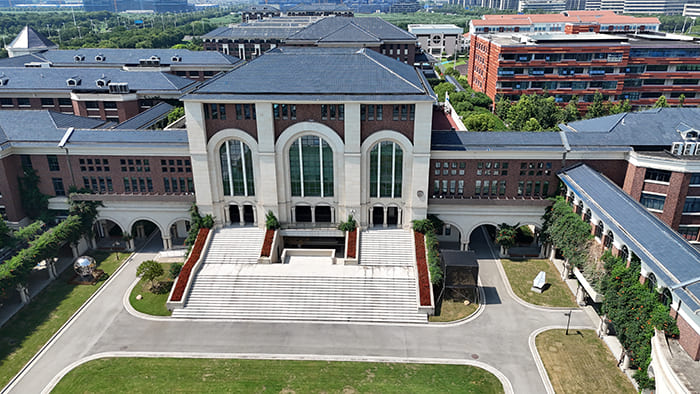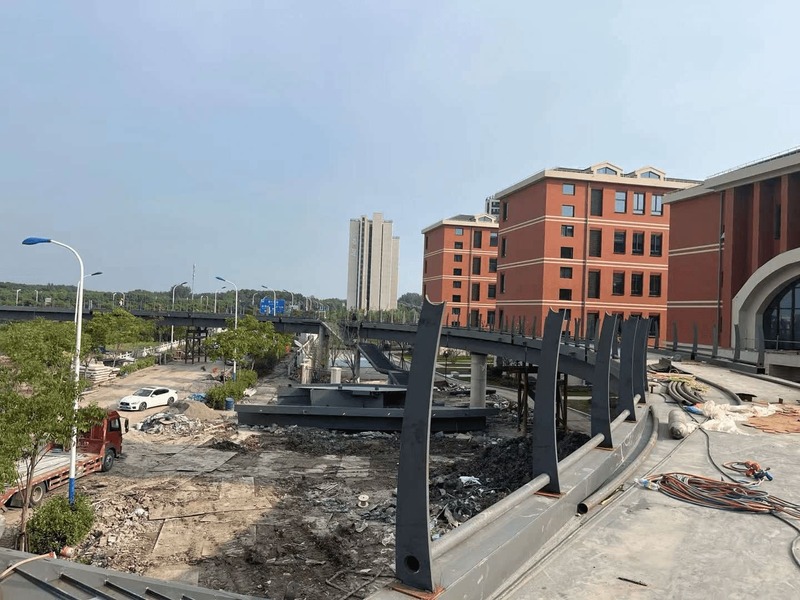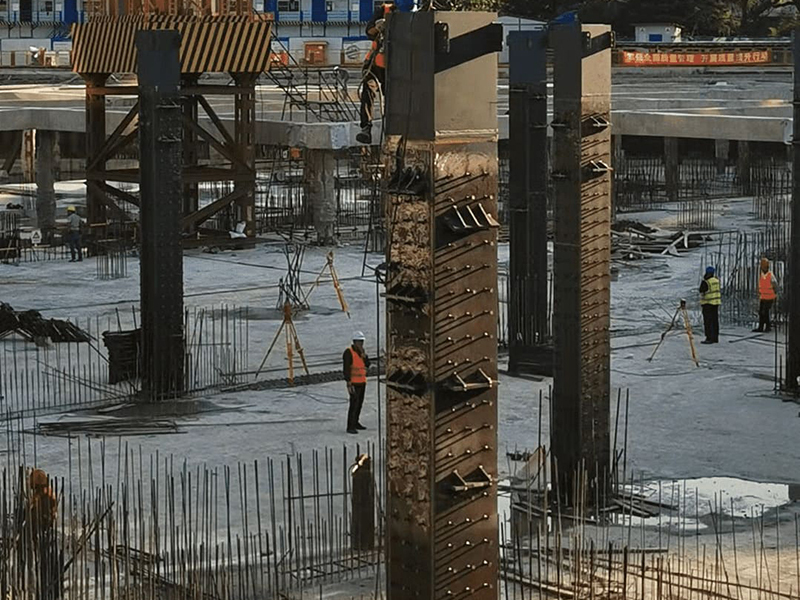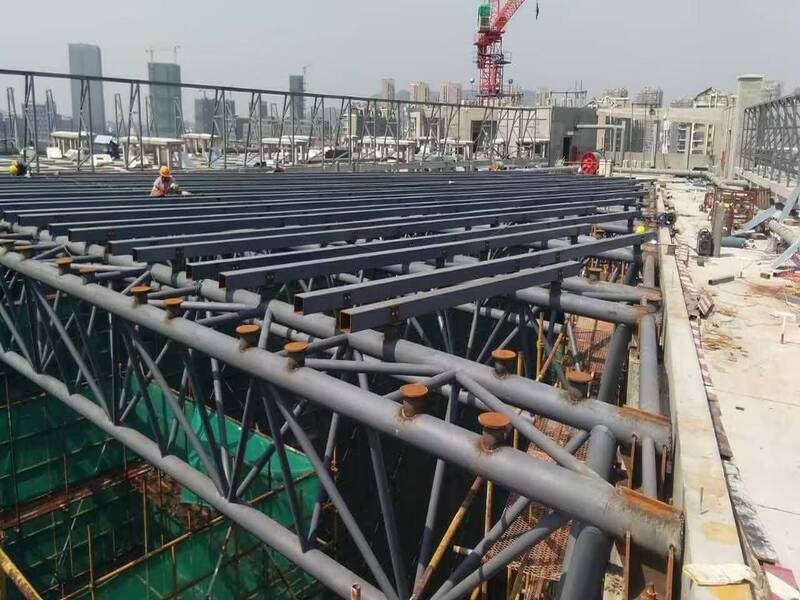1. Typical applications of steel structures in school buildings
The functional characteristics of educational buildings are essentially the spatial practice of the “student-centered” concept. When traditional concrete buildings gradually show their limitations in terms of large-span space and flexible layout, steel structures break through with the modular thinking of “building schools like building blocks.”
1.1 Teaching building/laboratory building: steel-concrete composite structure
- Structural advantages: Using Q355B high-strength steel frame + concrete floor, the single span can reach 12 meters, the space utilization rate is increased by 25%, and the classroom can be flexibly divided into an open learning space.
- Construction efficiency: Modular prefabricated components were assembled on-site, and the main structure of the 6-story teaching building was completed in just 90 days, 50% shorter than traditional processes.
- Safety performance: Earthquake resistance level reaches 8, anti-continuous collapse design, suitable for crowded scenes.
1.2 Stadium/Gymnasium: Large-span space trusses
- Column-free space: The largest single span is 80 meters, which can accommodate more than 2,000 people in the stands, meeting the needs of multi-functional events such as basketball and badminton.
- Typical case: The steel structure gymnasium of a middle school completed its main structure topping-out in 45 days and became a benchmark venue for regional sports events.
- Intelligent configuration: The standard photovoltaic skylight has a light transmittance of 60%, which can save 30% of electricity bills annually; the acoustic design controls the reverberation time to ≤1.8 seconds, saying goodbye to echo interference.
1.3 Student dormitory/canteen: Standard portal frame
- Flexible expansion: The modular design supports the later construction of corridors or elevators. Dormitories can be quickly transformed into loft-style double-story spaces, increasing bed density by 40%.
- Economical and efficient: Using American standard A36 steel prefabrication, the unit cost is as low as $ 220- 300 USD/㎡, which is 30% lower than the traditional brick-concrete structure.
- Green and environmentally friendly: The exterior wall is made of 150mm rock wool sandwich panels with a sound insulation of 55dB, ensuring that students can rest quietly; the steel is 100% recyclable, reducing construction waste by 90%.
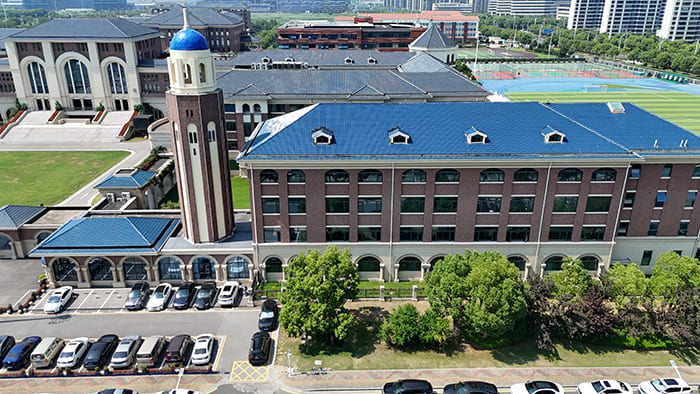
2. Why should schools choose steel structures?
School building safety is the bottom line requirement for educational infrastructure, and the shortcomings of traditional construction models in terms of seismic toughness and construction efficiency have made it difficult to adapt to the needs of the new era. Steel structures, with their characteristics of “high strength, light weight, and fast construction”, have become the key solution to solving the problems of educational infrastructure.
2.1 Safety performance: protecting the lives of teachers and students
Steel has an elongation rate of over 20%, its self-weight is only 1/3 of that of concrete, and its earthquake inertia force is reduced by 40%, which has good earthquake resistance advantages. Earthquake data shows that the integrity rate of steel structure buildings is 67% higher than that of concrete. The fire protection system uses ultra-thin fire-retardant coatings with a fire resistance limit of 2.5 hours. It is equipped with an intelligent smoke detection system, which can complete the fire linkage of the entire building within 5 minutes.
2.2 Fast construction: no delay in the start of school
The 2,000-square-meter teaching building of a primary school took only 120 days from foundation laying to completion, and was delivered 4 months ahead of traditional technology. It used the factory prefabrication + on-site assembly mode: 70% of the components were processed in the factory, there was no wet work on site, and construction could be carried out in both the rainy season and winter.
2.3 Green and sustainable: Practicing the concept of a low-carbon campus
Low carbon emissions: The carbon emissions per unit area are 1.2tCO₂/㎡, which is 63% lower than the concrete solution, helping the school apply for green building certification.
The annual power generation of the photovoltaic integrated roof can meet 30% of the cafeteria’s electricity demand, achieving energy self-sufficiency and reducing operating costs.
2.4 Flexible transformation: adapting to the upgrade of the education model
Space remodeling: Steel structures can be disassembled and reorganized, and classrooms can be converted into laboratories, maker spaces, or lecture halls at any time. The cost of transformation is only 1/3 of that of concrete structures.
Smart integration: BIM technology pre-lays pipelines, supports the later installation of IoT systems such as facial recognition and smart lighting, and creates a digital campus.
3. Application scenarios and technical solutions of school building
The diversity of educational scenarios determines the differentiation of architectural solutions. From international hub airports to campus playgrounds, steel structure technology demonstrates amazing adaptability: it can not only support the grandeur of a 10,000-person gymnasium with an 80-meter column-free space, but also build economical and practical school buildings with standardized modules.
| Building Type | Applicable structure | Key Performance | Cost Reference |
| Classroom Building | Steel-concrete composite frame | 12m single span, seismic grade 8, multimedia classroom compatible | $380-450 USD/m² |
| Gymnasium | Pipe truss + space frame | 80m column-free span, supports 5t/m² ceiling equipment | $600-750 USD/m² |
| Student Dormitory | Standardized portal frame | Up to 6 floors, 60-day construction, expandable balconies | $280-350 USD/m² |
| Cafeteria | Steel frame + light steel roof | Equipped with fume purification, Class A fire rating | $320-400 USD/m² |
| Stadium Stand | Cantilever steel truss | 15m cantilever length, ≥3m emergency exit width | $500-620 USD/m² |
4. Comparison with traditional concrete school building: Data proves the advantages
When we place steel structures and traditional concrete solutions in the four-dimensional coordinate system of “safety, efficiency, environmental protection, and economy”, a series of comparative data reveal not only the technological gap, but also the upgrade of development concepts: from “building houses” to “creating ecology”, from “one-time investment” to “full-cycle operation”, steel structures are redefining the value dimension of educational buildings.
| Core Performance | Steel structure scheme | Traditional concrete solution |
| Earthquake resistance | Level 8 (GB50011 standard) | ≤7, high-intensity areas need reinforcement |
| Construction period (3000㎡ ) | 120 days | 270 days (28 days of maintenance required) |
| Carbon emissions | 1.2tCO₂/㎡ | 3.1tCO₂/㎡ |
| Renovation cost | Reduce by 60% (modular disassembly and assembly) | Need to be demolished and rebuilt, high cost |
| Space Utilization | Improved by 30% (column-free design) | Limited by columns, the corridor accounts for a large proportion |
| Recycling value | Steel recycling income reaches 15% of the construction cost | Concrete has almost no recycling value |
5. Main components and material standards
The foundation of building quality lies in the “seriousness” of materials and processes. In the technical system of XTD steel structure, the compressive strength of a steel column, the sound insulation index of a roof panel, and the flaw detection standard of a weld all carry the responsibility of a “century-long project”. It is not only a confident display of the quality of “Made in China” but also a concrete manifestation of the promise of a “safe campus” – the precise combination of each component is a silent protection for the safety of teachers and students.
5.1 Load-bearing system
Steel columns: Made of Q355B high-strength steel, with a compressive strength of 345MPa, anchored with M30 anchor bolts at the column base, with a wind load resistance of 1.5kN/㎡. Truss beams: Maximum span of 30 meters, box-type section (800×600×16×25mm), suitable for large span requirements of teaching buildings.
Floor: Corrugated steel plate + 100mm concrete composite floor, with a sound insulation of 45dB, ensuring that teaching on the upper and lower floors does not interfere with each other.
5.2 Enclosure and safety system
Exterior wall: thick rock wool sandwich panel + real stone paint finish, thermal insulation performance reaches K=0.5W/(㎡・K), warm in winter and cool in summer. Fire protection system: full coverage sprinkler + intelligent fire alarm, evacuation channel width ≥2.4 meters, in line with the “Primary and Secondary School Design Specifications”. Acoustic design: perforated sound-absorbing panels are installed on the walls of the classroom, and the indoor noise is ≤40dB, which is better than the national standard (≤45dB).
6. Frequently Asked Questions
Q1. Safety performance: How to ensure the safety of teachers and students?
A: Steel has super ductility, with an elongation of more than 20%. This means that when deformed by force, the steel can stretch like a rubber band without breaking, greatly improving the flexibility of the structure. At the same time, its own weight is very light, only one-third of that of concrete, which is like building blocks with lighter materials. Not only is construction more convenient, but it can also effectively reduce the inertia force generated during an earthquake by up to 40%. Under the stringent requirements of 8-degree earthquake fortification, the integrity rate of steel structure buildings is 67% higher than that of concrete buildings, and the advantage is very obvious.
In addition, the steel structure uses tough steel connections at key nodes, which are like putting on a “safety armor” for the building. Even if it is partially damaged, it can avoid the risk of chain collapse. In terms of fire resistance, the fire resistance limit of the steel structure can reach 2.5 hours, far exceeding the 1.5-hour standard stipulated in the “Building Design Fire Protection Code”, which buys more precious time for the safe evacuation and rescue of teachers and students.
Q2. Construction cost: What is the initial investment and long-term cost performance?
A: Modular production greatly reduces costs. Steel structure buildings adopt a modular production mode, and most of the construction links are moved to the factory to complete, which can save a lot of money. At present, the cost of standardized portal frame dormitories per square meter is between $220 and 300 USD, which is 30% cheaper than traditional brick-concrete structures.
The maintenance cost of steel structure buildings is also quite cost-effective, with annual maintenance costs being only 40% of those of concrete buildings. Its anti-corrosion coating is refurbished every 5 years, at a cost of 8 to 12 US dollars per square meter each time. Take a middle school cafeteria as an example. After using steel structures for 10 years, the operation and maintenance costs have been reduced by 25% compared to the budget. In the long run, the money saved is not a small amount.
Moreover, 100% of steel can be recycled and reused. When a building completes its mission and needs to be demolished, the benefits of recycled steel can reach 15% of the construction cost. In contrast, concrete buildings can only be treated as construction waste after demolition, and have almost no recycling value.
Q3. Spatial flexibility: Can it adapt to changes in education models? Can classrooms be quickly transformed? Is it convenient for future expansion?
A: One of the outstanding advantages of steel structure buildings is that their modular design can achieve flexible and changeable space. Taking the steel frame structure as an example, the single span can reach 12 meters. This column-free, large space design allows the interior layout to be freely divided according to actual needs. For example, in just 3 months after the start of school, a primary school used removable partitions to cleverly transform the original 10 ordinary classrooms into 5 laboratories and 5 maker spaces. Such a transformation is not only efficient but also extremely low-cost, with the transformation cost being only one-third of that of a concrete structure.
The loft transformation of dormitory buildings is also a classic application of modular design. The characteristics of standardized portal frames make it easy to add a second-floor platform. This not only greatly increases the density of beds by 40%, but also effectively solves the problem of tight accommodation. For example, a university dormitory area successfully added 200 beds in this way without additional land acquisition.
In the construction process of steel structure buildings, BIM technology plays a key role, and it provides a convenient upgrade interface for the building. Through BIM technology, the accuracy of pre-buried pipelines can reach ±5mm, which means that when installing elevators, air conditioners, and other equipment in the later stage of the building, there is no need to destroy the main structure. A middle school complex building is a good example. After 5 years of use, a new elevator was added due to demand. With the advantages of steel structure and BIM technology, the entire construction cycle took only 15 days, while traditional buildings took 3 months to complete the same project. The difference between the two is significant.
| Application Scenario | Advantages of steel structure | Actual cases and results |
| Classroom space transformation | The steel frame structure has a single span of 12 meters, a large column-free space that can be freely divided, and a low renovation cost (only 1/3 of the concrete structure) | Within three months of the start of the school year, a primary school used removable partition walls to transform 10 ordinary classrooms into 5 laboratories + 5 maker spaces. |
| Dormitory loft renovation | Standardized portal frame supports the construction of a second-floor platform to increase bed density. | A university dormitory area added 200 beds in this way without the need for additional land acquisition |
| Post-construction upgrades | BIM technology reserves upgrade interfaces, pipeline pre-buried accuracy is ±5mm, installation of equipment does not damage the main structure, and the construction period is short | A middle school complex building was built with an elevator after 5 years of use, with a construction period of only 15 days (traditional buildings take 3 months) |
Q4. How long is the construction period of a steel structure school? Can it meet the requirements for the start of school?
Steel structure schools have shown great advantages in the construction period. Taking the common 2,000㎡ teaching building as an example, the standard construction period of a steel structure school only takes 4-6 months, while traditional concrete buildings often take 8-12 months. There are three main reasons behind this:
First, the steel structure adopts a modular production model. Key components such as steel beams and steel columns are precisely processed in the factory and transported to the site for assembly, like building blocks. The biggest advantage of this method is that it is not affected by bad weather. Whether it is a continuous rainy season or a cold winter, the production progress in the factory will not be interrupted, and the on-site assembly speed will be faster.
Secondly, steel structures are particularly suitable for cross-operation. While the main structure is being constructed, water and electricity lines can be laid, fire protection facilities installed, and indoor and outdoor decoration can be carried out simultaneously. Each type of work can be “done separately”, and unlike traditional construction, it is not necessary to wait for the previous process to be completely completed before starting the next one, which greatly reduces the waiting time for the process connection.
Finally, the acceptance process is more efficient since steel structure components are all standardized and produced in factories, the quality is strictly controlled, and the on-site inspection items and processes are relatively simplified. In this way, the completion acceptance cycle can be shortened by 15-30 days. In some emergencies, such as post-disaster reconstruction and urgent expansion of schools, steel structure schools can even complete the entire process from construction to delivery within 60 days, truly achieving “rapid implementation”.
* Steel structure schools have great advantages in the construction period. Taking a common 2,000 square meter teaching building as an example, the standard construction period of a steel structure school is only 4-6 months, while traditional concrete buildings often take 8-12 months. There are three main reasons behind this:
| Compare Projects | Steel Structure School | Traditional concrete building |
| Construction period | 4-6 months | 8-12 months |
| Production Mode | Modular production, precise processing of components in the factory, on-site assembly, not affected by weather | Mainly cast on site, easily affected by the weather |
| Working method | Suitable for cross-operation, simultaneous construction of multiple types of work, and reduced waiting time for the process | Construction needs to be done in sequence, and the waiting time for the process connection is long. |
| Acceptance Process | Standardized production of components, controlled quality, simplified testing items and processes, shortening the completion acceptance cycle by 15-30 days | The acceptance process is cumbersome and time-consuming |
| Emergency delivery | Construction to delivery can be completed within 60 days | Difficult to complete in a short time |
In some emergencies, such as post-disaster reconstruction or when schools urgently need to expand their capacity, steel structure schools can even complete the entire process from construction to delivery within 60 days, truly achieving “rapid implementation.”
Q5. Is the post-maintenance of the steel structure school complicated? How to ensure the anti-corrosion and fire prevention treatment?
Steel structure maintenance is straightforward and cost-efficient when proper protective measures are taken early on. Among these, anti-corrosion treatment is the most crucial. The dual-layer protection of hot-dip galvanizing + fluorocarbon coating acts as a durable “armor” for the steel surface. With a galvanized layer thickness of over 85μm, the steel is shielded by a rust-resistant film, allowing it to remain in excellent condition for 10 to 15 years with only minor repainting of worn areas.
Fire prevention in steel structure school projects also has professional, reliable solutions. Applying thick fire-retardant coatings ensures a fire resistance limit of more than 2 hours, while installing rock wool fireproof panels strictly follows the Technical Code for Fire Prevention of Building Steel Structures (GB51249). Conducting integrity tests on the fire-retardant coating every five years helps identify potential issues early and guarantees long-term safety.
Daily inspection is equally important for maintaining the durability of an educational building. Maintenance teams focus on critical connection points, such as bolts and welds, checking for rust or wear. With advanced techniques like infrared flaw detection and ultrasonic testing, even hidden structural risks can be uncovered. Thanks to this systematic maintenance approach, annual costs remain only 1%–3% of the total construction cost—significantly lower than those of traditional buildings.
As one of the pioneering steel structure building service providers in China dedicated to the education sector, we have successfully contributed to landmark projects such as Dongchang Middle School Affiliated to East China Normal University (winner of the China Steel Structure Gold Award), the Fifth Middle School Affiliated to East China Normal University, and the Chengnan New District Education Cluster in Fuyang City. Through these projects, we have gained extensive experience in planning and constructing high-quality steel structure school facilities.
In practice, we have introduced innovative solutions such as fully assembled steel structure systems, seismic energy dissipation support technology, and modular construction methods. With a deep understanding of campus needs, we consistently deliver safe, durable, flexible, and intelligent steel structure solutions for educational building projects—earning long-term trust as a strategic partner for education systems across multiple regions.

